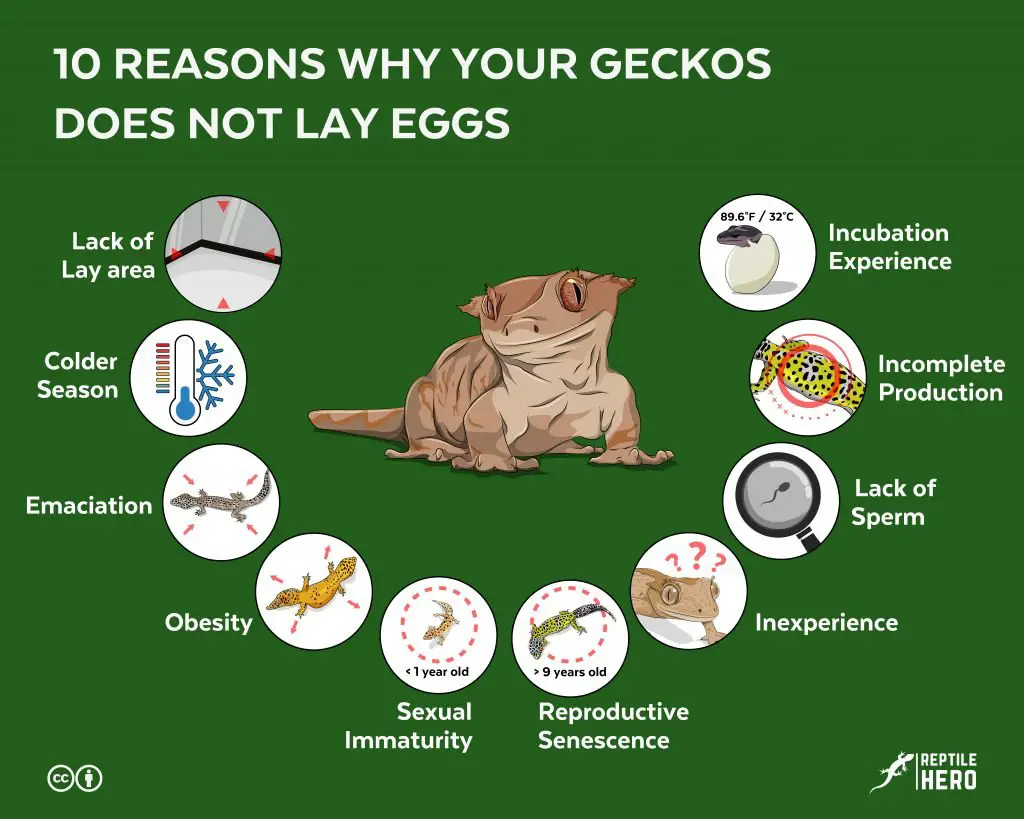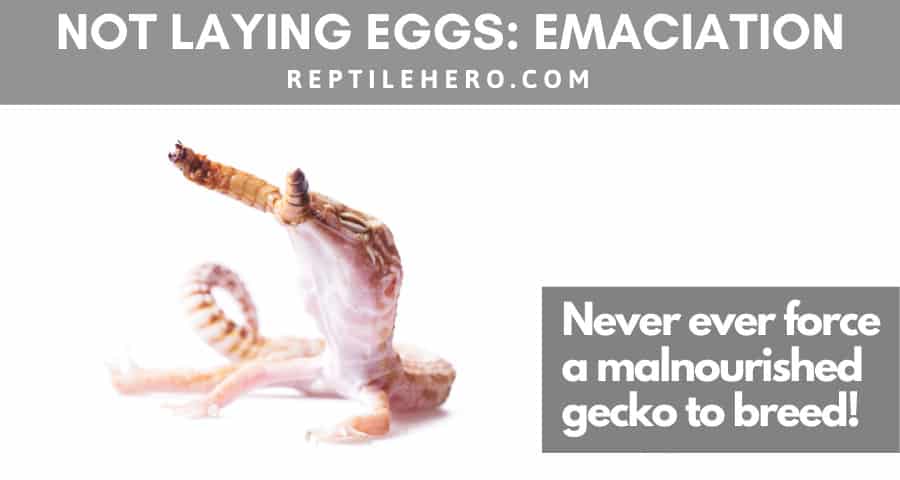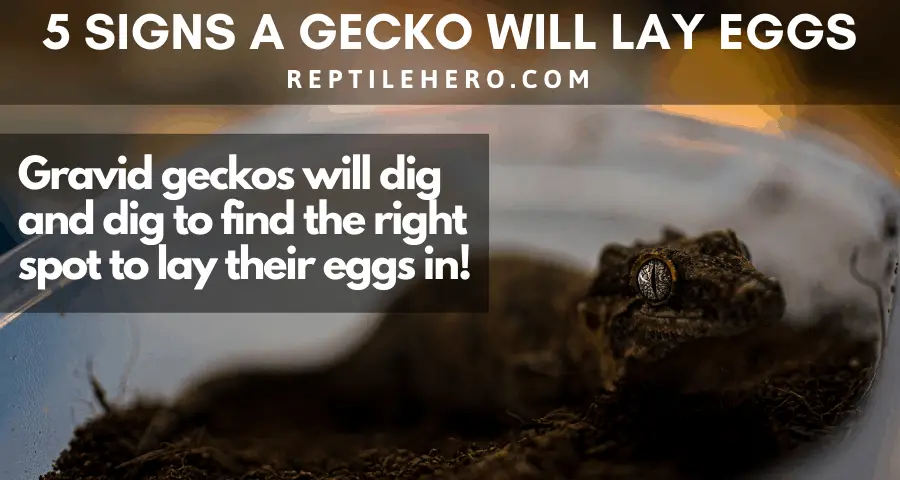10 Reasons Why Your Gecko Does Not Lay Eggs [with Solutions]
Geckos are pretty sexually active during their natural breeding season thanks to their instincts, much like many other animals. I have come across stories of females seemingly unable to lay eggs – but why does this happen?
As a general rule, a female gecko will not lay eggs due to the following reasons:
- Lack of lay area
- Colder season
- Emaciation
- Obesity
- Sexual immaturity
- Reproductive senescence
- Inexperience
- Lack of sperm
- Incomplete production
- Incubation experience
However, a gecko owner can address such issues with or without professional help.
Curious as to why your gecko is not laying any eggs? Then let me lay out the facts for you!
10 Reasons Why Your Gecko Is Not Laying Eggs!
Whether you’re reading this at the beginning of the breeding season, right in the middle, or just as it’s ending, you’re probably hoping to get good eggs sometime soon. However, there are a multitude of things to consider when you’re expecting your cute little lady to lay eggs that could lead to utter disappointment and heartbreak if not resolved!

#1 – Lack of Lay Area
Without an appropriate lay area with a moist substrate your gravid gecko can burrow into, she will not lay any of her fertile eggs because depositing soft-shelled gecko eggs in an open area will not ensure their survival.
Gravid geckos can be incredibly fussy and picky about things that may seem quite weird to us. This is especially true for most geckos who produce calcified but relatively delicate eggshells. Unlike the few geckos – such as tokays – who lay hard-shelled eggs that can survive with little care and attention, the majority of gecko species – including pet favorites like leos and cresties – have been hardwired to bury their eggs into the ground.
Though these little dragon-like creatures have been kept in captivity for a few decades now, they have retained the instinct as doing otherwise in the wild would leave them vulnerable to changing temperature and humidity as well as predators.
So if you have tank bedding that they can’t dig through (e.g., shelf liners, paper towels, reptile carpet) and also don’t have a dedicated lay box placed in their enclosure, then your little gecko lady will likely instinctively refuse to lay her eggs. When this is left unaddressed, your gravid gecko may suffer from dystocia, more commonly known as egg retention or binding.
Solution
There are two solutions for this issue. You can either place a lay box in your gecko’s vivarium or change your substrate completely. But I would recommend that you do both.
Lay boxes are cheap and easy to make. For the box itself, you can use a clean plastic food container or a shoebox (here on Amazon). The size is an important thing to consider, it should be small enough to fit inside the tank but large enough for a gecko to move around in.
Some people have recommended perlite and vermiculite which are also used for incubation, but I would advise against them. I have heard of stories where geckos die after accidental ingestion. Go for more natural materials which have been sterilized, such as peat moss or coconut fiber (here on Amazon), as they can safely pass after swallowing it unintentionally. Regardless, make sure it’s at least 2 inches deep for the eggs to be fully covered. Mist this as well.
Take a look at this gravid crestie hard at work, digging around her lay box in preparation for laying:
I get why other keepers prefer using sheets of paper towels and the like for tank substrate because it’s much easier to clean and replace. The lay box is the perfect solution for people who like to keep a low maintenance vivarium. However, switching to a more natural alternative provides for a place that mimics a gecko’s natural habitat so they will feel more okay with laying their eggs even without a lay box.
The problem with that, though, is contamination. If your gecko lays their eggs in dirty bedding, it could develop molds especially when it is kept moist.
#2 – Colder Season
It is normal for geckos to stop laying eggs once the temperatures drop. Geckos living in temperate areas usually stop laying eggs before winter sets in. Meanwhile, geckos in tropical areas stop laying eggs when the rainy season starts.
Remember that colder seasons could lead to brumation – a phenomenon similar to hibernation – in geckos, and reptiles in general. Because this translates to less food available in the wild, geckos usually stock up on food before it gets colder and darker outside.
During this period, they also move around a lot less as they may become prey for starving predators and they need to avoid expending the little fat reserves they have left. So a gravid gecko may either choose to lay eggs way before temperatures drop or stop ovulating in the meantime to survive this tough time.
Though geckos aren’t exactly known for being social creatures with strong familial ties, they inherently lay eggs during warmer days to ensure that their offspring will not die off when incubated at low temperatures for a long time. Laying their eggs at an earlier time also ensures that both they and their hatchlings could bulk up enough to survive the cold [1].
Some breeders say that this is extremely important so that female geckos can rest and replenish. As such, they would personally induce this by gradually lowering temperatures and reducing “daylight” hours in their paired geckos’ breeding tanks. They call this the cooling down period. Whether or not this is entirely different from brumation isn’t clear to me.
Solution
Let your female gecko rest and bulk up as much as she can so she’ll be ready for breeding seasons once winter ends and temperatures start to rise again.
If your gecko still hasn’t started laying eggs after the winter or rainy season, you can raise their enclosure temperature gradually into the 75-80°F (23-26°C) range to stimulate mating and egg-laying behavior.
#3 – Emaciation
An underweight adult gecko will have no extra fat, vitamin, and mineral reserves needed for egg production and deposition despite being already sexually mature.
As you may already know, producing and laying eggs are neither easy nor effortless. It takes a toll on even healthy geckos, so just imagine how worse it could be for an underweight gecko to be forced into breeding.
Geckos may lose weight for a myriad of reasons with varying degrees of severity. It could be due to recent egg-laying, brumation, insufficient diet, stress, tail loss, or a serious disease that could easily lead to death.
The exact weight range will vary depending on your gecko’s specific species. A mature female crested gecko is already underweight if it is anything under 30 grams, while a mature female leopard gecko could only be considered underweight if it is under 50 grams. This is one of the many differences between these two most popular pet species.
So before you consider your gecko for a breeding project, always check that they are on a good weight, even a little more chunky than normal so that they won’t drastically lose weight after producing and laying eggs.

Solution
Help your gecko bulk up by offering them more food – 1/4 of their entire diet should be composed of fatty live feeder insects and other food items rich in protein and fat, like meat and eggs.
Make sure to offer them additional vitamin and mineral supplements as well to prevent denting even if you gut-load and dust all insects you feed your geckos.
By bulking up, they can safely utilize their fat bodies and other reserves to produce healthy viable gecko eggs without losing everything they have stored for themselves.
#4 – Obesity
Geckos that are obese may suffer from both pre-ovulatory stasis and post-ovulatory stasis. The former may be a result of improper maturation of non-shelled follicles, where they fail to fully ovulate. The latter could be due to poor muscle mass and tone.
Although I previously said that female geckos should be fattened up, you should never go overboard. Overfeeding geckos before breeding season, especially with diets that are mainly made up of just fatty feeders, like waxworms, actually puts them at greater risk of suffering from egg-related conditions.
Contrary to popular belief, emaciation isn’t the only body-mass-related cause of egg retention in reptiles. Geckos, obese or not, who have developed mature follicles but fail to ovulate usually simply reabsorb them. However, there are times when these persist growing in a female reptile’s ovaries without fully developing [2].
Without expert assessment, it will be hard to determine whether a female gecko is actually gravid with viable eggs or if it’s actually holding enlarged follicles. In the past, a fellow pet parent experienced having their concerns about her gecko still not laying her eggs invalidated, some even mocked her for being paranoid. But upon visiting their exotic vet, she found out that her baby has more than a dozen small and big follicles. Since they discovered it late, surgery was the only option. Fortunately, her delicate little lady pulled through.
Plus, since geckos kept in captivity are fed regularly but have reduced activity due to limited vivarium space, they are prone to putting on a lot of weight. Being heavier than they should be, overweight and obese geckos are likely to be less active due to difficulty in moving. Due to either of these, they lose muscle mass and tone which is essential in successfully laying an egg or two [3].
I have heard a few keepers and breeders claim that overweight geckos are unable to successfully retain sperm obtained from mating, however, I have yet to find actual evidence for this. So for now, it’s still just a theory.
Solution
Put your gecko on a diet. Swap out all of their fatty live feeder insects with leaner ones (i.e., more protein compared to fat content), like crickets. Reduce feeding frequency as well. Don’t worry about them starving. Geckos can go for days without food and water.
In addition to a change in diet, encourage your gecko to explore around its enclosure. Add rock ledges, vines, and hides. You could also let them forage for their food instead of feeding them directly using tongs so they can exercise.
#5 – Sexual Immaturity
Generally, female geckos should be at least 1 year old and should fall within the average range of healthy body mass for adults of their species to be considered sexually mature.
Though some species are known to have the ability to reproduce by the time they are only 6 months old [4], most geckos keepers in the community are vehemently against it. The first reason being that such practice is simply unethical. This standard is not only seen or heard from reptile pet parents, this goes for all pets.
Nowadays, even expert breeders advocate for waiting until geckos, male and female, reach 2 years of age before pairing them up for mating. Again, age goes hand in hand with weight so take the earlier two reasons I’ve already covered.
Forcing juvenile and subadult geckos to produce and lay eggs hosts a number of health problems that cause death if not resolved. Keep in mind that since they are still growing, they need all the food they can take – to a healthy extent – to become healthy adults.
Solution
Let them be the spunky little geckos they are and patiently wait until they reach sexual maturity, in both age and weight. Just continue caring for them the best you can with a good vivarium and provide them with the best quality food you can get.
#6 – Reproductive Senescence
There is evidence which suggests that some reptiles may experience reduced fertility and overall loss of the ability to produce eggs as they age. Whether or not geckos actually go through a life event similar to menopause is still unclear. Some reports indicate they stop laying eggs as early as 9 years old, while others have geckos who laid eggs until their last year of life.
If you haven’t figured it out yet, I have been a keeper for years. However, since most people in my family tend to shy away from any animal that is not conventionally cute or furry, I had to scour the internet for all the advice I could get during my first few months and years of gecko-keeping.
From the groups and forums I have joined, I came across the interesting topic of geckos possibly having menopause. So I did a little digging into the topic. What I found out was that there is unfortunately very little definitive scientific information about it.
The few studies I found did mention that since the majority of vertebrates undergo deterioration of physiological functioning with age, called senescence, it would only make sense that geckos could face a decrease in reproductive ability too [5]. Furthermore, older female geckos are more likely to experience complications during egg production and laying.
Despite the lack of documentation of this phenomenon in geckos – and most other reptiles – many experienced keepers and breeders do share experiences of geckos as young as 9 years old or as old as 15 years old exhibit decreased egg clutches and viability. A handful even stop producing eggs altogether.
With all that said, some also report that their geckos never stop producing good and healthy eggs until they actually leave this world. So nothing’s set in stone. We still need more research on it to know for sure.
Solution
Don’t continue breeding them. Keep them as pets instead. If you still want to conduct breeding projects, be it for passion or for business, look for a younger gecko to breed.
Also, even if your lovely female gecko continuously produced eggs well into her adulthood, I would advise against intentionally having her breed. Retire her as soon as she’s 9 years old or as late as 15 years old. If she’s housed with her usual breeding mate, consider giving her her own tank.
#7 – Inexperience
A gecko that will be producing and laying eggs for the very first time may experience mild issues such as premature or delayed deposition.
It is completely normal for a female gecko to experience slight difficulties with eggs after mating for the first time ever. Some gecko owners even speculate that a gecko may not produce any eggs at all after their first breeding season as they do not entirely know what to do with the sperm they have obtained.
I can see why they would think this, however, I doubt that this actually explains the situation. For me, a more probable cause would just be the inability of the sperm to fertilize developing eggs in a gecko’s ovary due to internal reactions to a foreign organism which may cause the animal’s immune system to kill the potentially dangerous unfamiliar cell.
Cryptic female choice (CFC) would also be a possible cause. This is an instinctual drive female animals are theorized to have which allows them to hold off sperm they deem unsatisfactory from fertilizing their eggs. You can read more about this in a previous article we published on egg infertility.
Solution
In the event that your first-timer shows no signs of ovulating weeks after breeding with a fertile male, you can stimulate breeding behavior by letting her stay in the same tank as her mating partner. This will get her more comfortable and familiar with her mate and will encourage more frequent mating within the breeding season.
You can also increase heat and hours of daylight exposure. As previously mentioned, female geckos tend to engage in breeding more actively during warmer weather usually experienced during spring and summer months.
Continue observing your already gravid gecko for abnormal changes in weight, appetite, and behavior. If they are not exhibiting anything unusual, they may simply still be figuring things out. Refrain from handling her too often or changing stuff in her tank, that might stress her. Once they do display worrying behavior and the like, contact your local exotic veterinarian.
#8 – Absence of Sperm
Geckos may stop laying eggs once they have run out of retained sperm. In rare cases, sexually mature geckos may be paired with a partner of the same sex and therefore don’t breed. Most commonly, this happens when one or both were incorrectly sexed.
Not many regular gecko keepers seem to be aware of the fact that geckos have the ability to retain sperm for years. This ability is termed amphigonia retarda in biology and zoology.
In effect, gecko pairs who are mainly kept in their individual tanks have fewer opportunities of copulating which in turn leads to fewer counts of retained sperm.
Female geckos who are kept primarily as pets have also shown to be less likely to lay eggs, even infertile ones. So you shouldn’t be surprised if your sole pet gecko who is a girl doesn’t lay eggs at all. This is, of course, with the exemption of the few species capable of asexually reproducing offspring, otherwise called parthenogenesis.
Although not a common occurrence, geckos getting wrongly sexed is not uncommon. Personally, I have heard of a story or two where amateur hobbyists have incorrectly tried to pair off two females for the breeding season.
It’s amusing to hear but probably frustrating to experience. Imagine having spent a lot of time and effort to find your female gecko a partner only to discover that everything you did was in vain.
Solution
The very first thing you should do is properly determine your gecko’s sex. A clear-cut determining factor of a gecko’s sex regardless of its species is the presence of femoral pores near its cloaca or vent. Males have them while females don’t.
Check this short video out to know what femoral pores actually look like:
Once you’ve got that covered and are sure you’ve got a male to pair with a female, house them permanently together for one whole breeding season if they get along after introduction. By doing so, your female will have more sperm stored. This ensures higher chances of your female laying eggs.
#9 – Incomplete Production
A gravid gecko may simply not be ready to lay its eggs as it is ensuring that the eggs it is creating in its ovaries are perfectly formed to weather through incubation.
This may happen in relation to all the other 8 reasons which have already been discussed by your truly. However, it could also be expected to happen exclusive of all that.
I am guessing that healthy and sexually mature geckos, whether experienced or not, would spend a lot of time to make sure it has allotted enough of its own resources to produce a good egg that would be a waste of effort. I have not come across definitive research to back up my claim, though, so take this humble assumption of mine with a grain of salt.
All things considered, a gecko may take anywhere between 2 to 5 weeks before finally being able to fully form a healthy and viable clutch of eggs she can lay without any adverse effects.
Solution
If you’ve only recently noticed that she has clearly formed eggs in her cold but soft belly, let her be. Give her enough time and space so that she can focus on producing good eggs for you.
Avoid disturbing her at this time as stressing her out during such a significant period could lead to health problems for her offspring and her. Don’t handle her too much and don’t rearrange her enclosure set-up.
Give her some privacy as well. It may sound ridiculous to you but no one, not even geckos, appreciates excessive attention. Especially when they are doing something important and are in a vulnerable state.
#10 – Incubation Experience
A female leopard gecko that has hatched from a male-biased warm incubation temperature (89.6°F or 32°C) will not produce nor lay eggs. This is likely true for other gecko species which experience temperature-dependent sex determination (TSD).
In a 1988 study on the sexual behaviors of adult leopard geckos and their incubation temperatures, researchers have found that the incubation temperatures affect behavioral and hormonal differences between sexually mature males and females [6].
On top of that, female leos that experience incubation set-ups known to primarily produce males (89.6°F or 32°C) – known as hot females – seem to be completely sterile. They did not lay eggs for the whole duration of the study.
Moreover, they have quite the reputation for being aggressive too, even towards aspiring mates. They may bite hard enough to puncture through skin and flesh. As such, housing them together with another gecko is not recommended, regardless of the partner’s sex.
Knowing this, we can safely assume that hot females from other gecko species that undergo TSD, such as the Madagascar day geckos or African fat-tailed geckos, may suffer from infertility as well.
Solution
Find out the incubation temperatures your female was hatched from. If she is a hot female, do not pair her up. Your male might not only be rejected but also receive serious injuries.
You don’t have a way to know your female’s incubation experience? That’s okay. Instead, just closely observe your female’s response to a potential breeding partner’s courting advances. Remember: hot females are highly antagonistic towards males.
Once she reacts with hostility (e.g., whipping its tail, striking to bite, etc.), immediately separate her.
However, do keep in mind that even a regular fertile female may behave this way if she is done breeding for the season or she is just not in the mood.
How to Check if Gecko is Really Gravid
Usually, it’s incredibly easy to check whether your gecko is gravid. You just need to sneak a peek at its belly for the developing eggs without any special tool or equipment. The eggs may be entirely white or have a yellow tinge at the center then have a pink outline.
Here’s another video to help you figure out whether your gecko is simply ovulating or is actually in the process of creating eggs:
However, not all geckos have light bellies. In such instances, you may need to shine a flashlight to her abdomen, by her lower mid-section. If after that you still can’t make out anything, you can call up your vet and schedule an appointment for radiography or ultrasound [7].
5 Signs a Gecko is Finally Going to Lay Eggs

When you’ve followed the solutions I have suggested for your egg-laying problems, I’m sure that you’re gecko is well on its way to laying eggs again next season. That is unless they are too old.
To reiterate, I do not support the continued breeding of old geckos. Come on, give them the peaceful retirement they deserve. All jokes aside, I’ve come up with a list of things a gravid gecko usually does before laying a clutch.
A gravid gecko ready to lay eggs may exhibit some or all of the following behaviors:
- Irritability. Even if your female is normally the sweetest little angel, she can be touchy and feisty if she’s about to lay her eggs out of maternal instinct.
- Change in activity. A few days before laying her egg, she may be relatively inactive – choosing to save her energy instead. However, a day before she lays an egg, she may explore her enclosure to look for a good laying area.
- Reduced food intake. Once a gecko is nearing the completion of its egg production, you may notice a gradual decrease in its food intake. A day or a few hours before laying an egg, it may even totally stay off food.
- Digging around. Though it is normal for some gecko species to burrow into the ground, gravid geckos that are known to produce soft-shelled eggs exhibit a markedly heightened digging activity. They may do this for hours on end before finally laying their eggs.
- Tensing hind legs. When you see a gecko stretching out its hind legs, she is preparing to finally pop out a fully formed egg or two – even three depending on its species’ average clutch size.
That’s all I’ve got for you in this article. If you have other questions or topics you’d like us to cover, hit us up here.
Takeaways
A gecko may fail to lay eggs for a number of different reasons: a lack of lay area, colder season, emaciation, obesity, sexual immaturity, reproductive senescence, inexperience, lack of sperm, incomplete production, or incubation experience.
Causes behind why a gecko is not laying eggs, however, can readily be prevented and addressed. With the only exception of reproductive senescence being the cause
You can tell that a gecko is gravid if it has a clutch of eggs formed in its belly. The egg will appear white with hints of yellow encircled by a pink band.
Tell-tale signs a gravid gecko will lay its eggs soon include irritability, change in activity, reduced food intake, digging around, and tensing hind legs.
Sources
[2] https://veterinary-practice.com/article/reptiles-how-to-deal-with-reproductive-disease
[3] https://vcahospitals.com/know-your-pet/reptiles—dystocia
[4] https://animaldiversity.org/search/?q=gecko&feature=INFORMATION
[5] https://www.researchgate.net/publication/41451337_Reptile_geriatrics
[6] https://www.researchgate.net/publication/19797868_Gutzke_WHN_Crews_D_Embryonic_temperature_determines_adult_sexuality_in_a_reptile_Nature_332_832-834
[7] https://www.veterinarypracticenews.com/when-to-intervene-in-reptile-parturition/

![Do Geckos Drink Milk? [Think it Twice]](https://www.reptilehero.com/wp-content/uploads/2021/07/Does-Gecko-Drink-Milk-Infographic-768x614.jpg)
![Do Leopard Geckos Need Heat Mats? [Myth or Truth]](https://www.reptilehero.com/wp-content/uploads/2022/03/does-gecko-needs-heat-mats-cc-768x614.jpg)
![Ceramic Heater vs Halogen For Leopard Gecko: Which is Best? [11 Factors]](https://www.reptilehero.com/wp-content/uploads/2021/08/che-halogen-comparison-gecko-small-cover-infographic.jpg)
![What Do Gecko Eggs Look Like? [Size, Color, and More]](https://www.reptilehero.com/wp-content/uploads/2021/03/word-image-25-768x576.png)

